


This chapter provides information on the current and projected forest use regimes and the capability of the forest resources to respect them. It first deals with use of forest for fuelwood followed by poles, pulpwood, timber and other forest products. In doing so, this chapter first presents the requirement of the forest products and then organizes the information on capability of forest resources in Bangladesh to meet these requirements
Bangladesh forests are surviving under high level of demographic stress. The production from forest areas is continuously declining and most of it is consumed within the country and a large quantity is imported to satisfy domestic consumption. The continual change in species and age group, and lowering of average age of forests is adversely affecting the sustainability of the current forest ecosystems.
Reported physical output (Table 41 at Appendix) indicate that production of timber and fuelwood form forest areas has fallen by more than 50% after the felling ban in 1988-89 (Fig. 24). However, the actual production after including private sources is much higher and is estimated at 7.9 million m3 of round wood of all kinds, and 656 million bamboos (FMP, 1992).
Fig. 24. Production of timber and fuelwood from forest areas
The wood is primarily used for meeting needs of fuelwood, sawn timber, poles, pulpwood and other products. This chapter uses "round wood" as unit of measurement because the "round wood" is common unit to express production and supply of wood in Bangladesh.
Fuelwood is the main forest product (61% of total round wood) in Bangladesh. The country annually requires about 9.4 million M3 (Table 42 at Appendix) of fuelwood against supply of about 6.18 million M3. Fig. 25 presents the share of domestic (like cooking), industrial (like brick burning), and commercial (like bakeries and restaurants) use of the total fuelwood consumption in the country (Table 43 at Appendix).
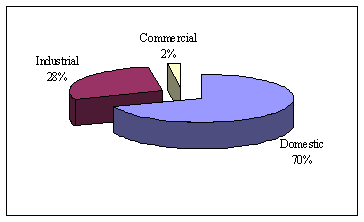
Fig.25. Share in use of fuelwood
The consumption is expected to rise (Fig. 26) to 11.9 million M3 by 2015. The fuelwood consumption in Bangladesh has an income and a regional pattern. The per capita consumption of fuelwood in Bangladesh increases with income, like 0.035 M3 for low income to 0.072 M3 for high income families. Further, the fuelwood energy use varies also with geographical locations like 1.1 million Kcal per annum in the dry north-west to 1.9 million Kcal per annum in areas near northern Sal forests.
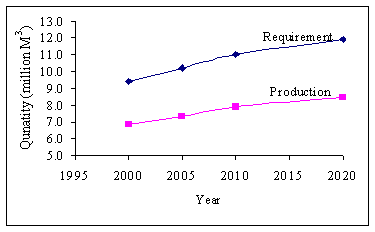
Fig 26. Requirement and production of fuelwood
The total fuelwood production is estimated as 6.8 million M3 in 2000 and it is expected to rise (Fig. 26) to 8.5 million M3 by 2015 (Table 44 at Appendix). This availability has significant regional variations, as major portion of the public forests is located in the eastern region. Other areas, which are densely populated, have to depend, to a great deal, on whatever is locally available like agricultural residues and homestead vegetation. Different studies (FMP, 1992) indicate that due to short supply, the use of fuelwood is declining and that of the agricultural residues is increasing. The majority of the fuelwood supply comes from the village groves. There exists some ambiguity as to the actual contribution of village groves in fuelwood production.
Total energy balance in 1990 indicated that the share of commercial energy was 27% (up from 17% in 1981) and that of biomass energy 73% (down from 83% in 1981). The households predominantly use biomass fuel for cooking (100 % in rural households and 70% in urban households) and kerosene for lighting (93% in rural households and 76% in urban households).
The annual requirement of different type and sizes of pole expressed in volume is estimated to increase (Fig. 27) from 0.3 million M3 in 1999 to 0.5million M3 in 2013. This estimate includes the domestic as well as the industrial requirement of poles like in rural electrification, power development, railway and port authorities and construction industry. The projection of domestic use of pole assumes a constant per capita use and therefore, estimates increases in use with increases in population. The industrial requirements are assumed to remain flat throughout the period.
Fig. 27. Requirement and production of poles
FMP, 1992 estimates of pole production indicates a dramatic increase (Fig. 4.4) in production of poles from 0.187 million M3 in 1999 to 0.316 million M3 in 2015 (Table 44 at Appendix). This prediction is based on the major structural changes that are happening in the forest growing stock like decline in average age, average diameter and percentage of valuable species, and increased supply of plantation material.
FMP, 1992 estimates that projected annual requirement of paper products of different categories (Fig. 28) will increase from 0.18 million Air Dry Tonne (mADT) in 2000 to 0.28 mADT in 2020 (Table 45 at Appendix). One half of the increase comes from more people, the other half from greater literacy. The pulp and paper industry ranks second in economic importance (value added) in among wood based industries in Bangladesh. The annual production is about 80 to 90% of the installed capacity (126,000 ADT) of paper and pulp units (Table 46 at Appendix).
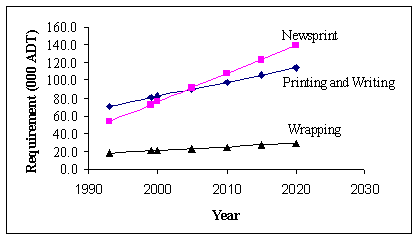
Fig. 28. Requirements of paper products
The requirement of pulpwood to meet the production needs of different categories of paper products is likely to increase (Fig. 29) from the level of 0.3 million M3 in 2000 to 0.5 million M3 in 2015 (Table 42 at Appendix).

Fig. 29. Requirement and production of pulpwood
The pulpwood production is expected to increase from 0.351 million M3 in 2000 to 0.550 million M3 in 2015 to meet the additional requirements (Table 44 at Appendix). The forest bamboo is expected to contribute roughly 60% of the pulpwood followed by hardwood (30%) and village bamboo (10%). The newsprint mills rely mainly on "Gewa" tree for meeting their demand of pulpwood.
The annual requirement of sawn timber is expected to rise (Fig. 30) from 5.4 million M3 (round) in 2000 to 6.8 million M3 (round) in 2015 (Table 42 at Appendix 4). The projection assumes a flat per capita demand and reflects the expected population growth during the period. Sawmills alone consume a large part of the above requirement (4.7 at Appendix 4). Bangladesh has more than 4,500 sawmills, each with a daily capacity of about 2 M3. About 4,500 sawmills were annually producing about 2.7 million M3 of timber and employing 33,000 persons in 1992 (FMP, 1992). In addition to this about 5,500 pit-saw units also use round wood to produce about 10,000 sleepers (400 M3 timber) every year.
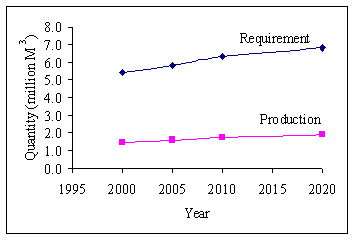
Fig. 30. Requirement and production of sawlogs (timber)
The sawn wood production is expected to increase (Fig. 30) from current estimated level of 1.45 million M3 (round) in 2000 to the estimated level of 1.9 million M3 (round) in 2015 (Table 44 at Appendix). The garjan, jam, chapalish, telsur and champa, gewa and sundri are main forest tree species that will supply the sawlogs. Teak is the dominant plantation species, followed by jarul, gamar, melocanna, eucalyptus, keora and mangium that will contribute sawlogs. The jackfruit, mango, shil koroi and raintree are main species in the villages that will augment the supply of sawlogs.
Private wood supplies are very significant, but are spatially skewed like public wood supplies. The southern and south-eastern regions have the best stock of private trees. Khulna, Barisal, Patuakhali, southern Comilla, Noakhali, Chittagong and Cox's Bazar districts have medium stock of private trees. The north-western region and Sylhet, western Mymensingh and northern Comilla have significantly lower stock of private tree resources.
Other solid wood products include veneer, plywood, matches and composite panel boards. At present the total round wood requirement is slightly over 200,000 M3 for these products. This requirement is included in the projected requirement of sawlog, pole and pulpwood. Although the projected requirements maintain a slightly increasing consumption rate, these products are not expected to become major demand items (FMP, 1992). Table 48 at Appendix provides consolidated information about the capacity and production levels in 1992 of different primary and secondary wood using industries in Bangladesh (FMP, 1992).
Most of the plywood units are old with total annual capacity of about 4.0 million sq. meters. Local production capacity appears far greater than the local demand for commercial plywood.
Bangladesh has about 18 matchwood units. Five of them are major producers (95%) of matchwood while the rest share the remaining five percent. The annual match production is about approximately 12.8 million gross boxes. Demand is declining during the period a result of the increased use of substitutes like electronic and gas lighters. The main supply used in the production of match splints currently comes from privately grown light-weight softwood species because of felling ban on "Gewa" from Sunderbans.
Bangladesh has about 42 units producing composite panel products (wet process hardboard and particleboard). Most of these units use fuelwood, forest residues and wood industry residues as raw material.
There are about 34,000 furniture making units, mostly at the cottage level, employing about 115,000 persons every year. These units mostly utilize the cheaper white woods rather than the more expensive decorative species like Teak.
In addition to the above, there are large but unsurveyed and unorganized numbers of other wood using enterprises producing a wide variety of products like rickshaw bodies, toys, sporting goods, agricultural implements, bobbins, shuttles, cart wheels, musical instruments, and domestic utensils etc.
Fig. 31 presents the consolidated picture of round wood requirements (FMP, 1992) for fuelwood, sawn timber, poles, and paper (Table 42 at Appendix). It increases from 15.4 million M3 in 2000 to 19.5 million M3 in 2015. The share of fuelwood in total requirement of round wood is maximum at about 61%, which is followed by sawn timber with share of about 35%.
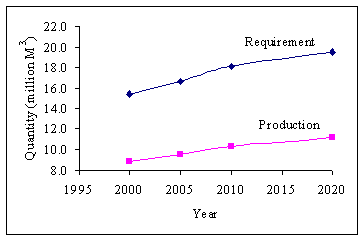
Fig. 31. Total requirement and production of wood
The annual total round wood production is expected to increase (Fig. 31) from the current level of about 8.8 million M3 to 11.2 million M3 in 2015 (FMP, 1992). Table 44 at Appendix provides consolidated information about the capacity of forest resources of Bangladesh to supply roundwood. This estimation assumes an increasing future reliance on plantation wood supplies and a corresponding decline in relative sawlog availability from forest species. This trend has two major implications (a) future supplies will become increasingly small and (b) the species proportions will change dramatically in favor of the plantation species. FMP (1992) predicts that by the year 2015, the share of plantation sawlogs and pulpwood in total wood production may go up to 30%. Another expected significant change is the large increase of pole material. This change may ask for new technologies, and provide different basket of final products.
Single stemmed "muli" bamboo dominates the forest bamboo resources, while the main bamboo species from villages are "barua", "bariala", "barak", "jali" and "makhal" bamboo. Bamboo resource distribution is apposite of the private tree resource pattern. Northwest, northeast and western region farmers hold 70% of the private bamboo resource, more than 13 culms per capita. However, in the north central and southeastern regions, and more particularly in the southern region, per capita bamboo falls below 11 culms, the average for the country.
The total supply potential of Bamboo in Bangladesh is about 722 million culms. The contribution of public forests is estimated at about 194 million culms and that of village forests at about 528 million culms (FMP, 1992). The present system of annual auctions and permits does not encourage investment in infrastructure such as roads and cable ways. As a result, part of the bamboo area remains inaccessible and the prescribed cutting rules are not consistently followed, resulting in high waste and unnecessary damage.
A large extent (51.86%) of the forest land is either blank, encroached, and under agriculture including shifting cultivation. These forest land under non-forestry uses (Table 49 at Appendix) have no or negligible forest cover. Most of the economically backward tribal population practices shifting cultivation on forest areas. Four identifiable tribes with a population of 0.5 million people reside mainly in the Chittagong Hill Tracts. Some tribal population is present in the northern parts of Mymensingh District. None of the past attempts to rehabilitate these tribal and shifting cultivation areas have succeeded. While the earlier efforts to address this issue focused on agriculture, the later ones had emphasized horticulture and afforestation.
Bangladesh is now heavily dependent on imports of forest and forest-based products for meeting its basic consumption. A huge trade deficit exists for the forest products. Primary imports of logs and sawn timbers are from countries like United States, Canada, Australia, Myanmar, Singapore and Malaysia. The GOB tries to contain import of forest products through imposition of duty and restriction on imports.
High density and rate of growth of population coupled with high incidence of poverty is exerting very high pressure on forest land. The huge illegal collection of fuelwood and unauthorized use of forest land for non-forestry purposes is very common and extensive. More than half of the forest land in Bangladesh is either blank or under illegal non-forestry use. Excessive use of remaining forest resources is pushing them towards their limits of resiliency. Public forests are mostly meeting large commercial and industrial needs.
Privately owned trees and bamboo resources are being harnessed at higher levels and are supplying more forest products than the public forests. Harvesting on private land by individual owners, timber traders and contractors accounts for the bulk of wood production. Privately owned trees are not under any scientific management and therefore it is difficult to ensure their sustainability.
Bangladesh faces increasing shortage of forest raw material supply for meeting its domestic and industrial needs. Future wood supplies will rely heavily on plantations and consist of increasingly small dimensions. Excepting supply of poles all other supplies will be much below the requirement. This will result in regular decrease in manufactured products available for export and domestic consumption, and increase in import of forest raw material as well as manufactured products.